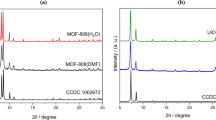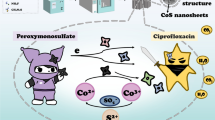Abstract
In the framework of the development of green analytical chemistry, a silica gel (SG) coated with a semi-penetrating network based on the partially biosourced poly(ethersulfone) is studied for a greener extraction process of aromatic organic pollutants. An optimized composition of the semi-penetrating network (80% of the linear polymer (LP): isosorbide-based poly(ethersulfone) and 20% cross-linking agent (XP) type bismaleimide) leads to a total adsorption of the selected aromatic pollutants, whatever their hydrophilicity. Adsorption characteristic, kinetics and isotherms of the SG-semi-INP LP80/XP20 for p-hydroxybenzoic acid and for toluic acid were studied. Langmuir model led to a better fitting of the adsorption isotherms; the adsorption of toluic acid is easier than that of p-hydroxybenzoic acid. 1/n values of benzoic acid was lower for SG-semi-INP LP80/XP20 compared to biochar and to cross-linked methacrylate resin, showing a higher adsorption efficiency.













Similar content being viewed by others
References
Evans AE, Mateo-Sagasta J, Qadir M, Boelee E, Ippolito A (2019) Agricultural water pollution: key knowledge gaps and research needs. Curr Opin Environ Sustain. https://doi.org/10.1016/j.cosust.2018.10.003
Levi Y (2020) Contamination des eaux par les résidus de médicaments et stratégies de prévention. Actual Pharm. https://doi.org/10.1016/j.actpha.2020.01.007
Wuxia B, Weng B, Yuan Z, Yang Y, Xu T, Yan D, Ma J (2019) Evolution of drought-flood abrupt alternation and its impacts on surface water quality from 2020 to 2050 in the Luanhe River Basin. Int J Environ Res Public Health. https://doi.org/10.3390/ijerph16050691
Bilal M, Mehmood S, Rasheed T, Iqbal HMN (2020) Antibiotics traces in the aquatic environment: persistence and adverse environmental impact. Curr Opin Environ Sci Health. https://doi.org/10.1016/j.coesh.2019.11.005
He X, Li P (2020) Surface water pollution in the middle Chinese loess plateau with special focus on hexavalent chromium (Cr6+): occurrence, sources and health risks. Expos Health. https://doi.org/10.1007/s12403-020-00344-x
Magalhaes KM, Carreira RS, Rosa Filho JS, Rocha PM, Santana FM, Yogui CT (2022) Polycyclic aromatic hydrocarbons (PAHs) in fishery resources affected by the 2019 oil spill in Brazil: Short-term environmental health and seafood safety. Mar Pollut Bull. https://doi.org/10.1016/j.marpolbul.2022.113334
Awad AM, Shaikh SMR, Jalab R, Gulied MH, Nasser MS, Benamor A, Adham S (2019) Adsorption of organic pollutants by natural and modified clays: a comprehensive review. Sep Purif Technol. https://doi.org/10.1016/j.seppur.2019.115719
Zango ZU, Sambudi NS, Jumbri K, Ramli A, Abu Bakar NHH, Saad B, Rozaini MNH, Isiyak HA, Osman AM, Sulieman A (2020) An overview and evaluation of highly porous adsorbent materials for polycyclic aromatic hydrocarbons and phenols removal from wastewater. Water. https://doi.org/10.3390/w12102921
Plotka-Wasylka J, Szczepanska N, de la Guardia M (2016) Modern trends in solid phase extraction: new sorbent media. Trends Anal Chem. https://doi.org/10.1016/j.trac.2015.10.010
Jagirani MS, Ozalp O, Sylak M (2021) New trends in the extraction of pesticides from the environmental and food samples applying microextraction based green chemistry scenari: a review. Crit Rev Anal Chem. https://doi.org/10.1080/10408347.2021.1874867
Jouyban A, Nemati M, Farazajdeh MA, Yazdani A, Afshar Mogaddam MR (2022) Salt-induced homogenous solid phase extraction of hydroxylated metabolites of polycyclic aromatic hydrocarbons from urine samples using a deep eutectic solvent as an elution solvent prior to HPLC-FLD analysis. Microchem J. https://doi.org/10.1016/j.microc.2021.106932
Nayl AA, Abd-Elhamid AI, Aly AA, Bräse A (2022) Recent progress in the applications of silica-based nanoparticles: review. RSC Adv. https://doi.org/10.1039/D2RA01587K
Saeed T, Naeem A, Din IU, Alotaibi MA, Alharti AI, Khan IW, Khan NH, Malik T (2020) Structure, nomenclature and viable synthesis of micro/nanoscale metal organic frameworks and their remarkable applications in adsorption of organic pollutants. Microchem J. https://doi.org/10.1016/j.microc.2020.105579
Han H, Rafiq MK, Zhou T, Xu R, Masek O, Li X (2019) A critical review of clay-based composites with enhanced adsorption performance for metal and organic pollutants. J Hazard Mater. https://doi.org/10.1016/j.jhazmat.2019.02.003
Gomri M, Abderrazak H, Chabbah T, Souissi R, Sain-Martin P, Casabianca H, Chatti S, Mercier R, Errachid A, Hammami M, Jaffrezic-Renault N (2020) Adsorption characteristics of aromatic pollutants and their halogenated derivatives on bio-based poly(ether-pyridine)s. J Environ Chem Eng. https://doi.org/10.1016/j.jece.2020.104333
Chabbah T, Abderrazak H, Saint-Martin P, Casabianca H, Kricheldorf HR, Chatti S (2020) Synthesis of Glux based polymers for removal of benzene derivatives and pesticides from water. Polym Adv Technol. https://doi.org/10.1002/pat.4953
Chabbah T, Abderrazak H, Souissi R, Saint-Martin P, Casabianca H, Chatti S, Mercier R, Rassas I, Errachid A, Hammami M, Jaffrezic-Renault N (2020) A sensitive impedimetric sensor based on biosourced polyphosphine films for the detection of lead ions. Chemosensors. https://doi.org/10.3390/CHEMOSENSORS8020034
Jlalia I, Zouaoui F, Chabbah T, Chatti S, Saint-Martin P, Casabianca H, Minot S, Bessueille F, Marestin C, Mercier R, Errachid A, Abderrazak H, Hammami M, Jaffrezic-Renault N (2021) Adsorption characteristics of WFD heavy metal ions on new biosourced polyimide films determined by electrochemical impedance spectroscopy. J Inorg Organomet Polym Mater. https://doi.org/10.1007/s10904-020-01842-w
Jlalia I, Chabbah T, Chatti S, Schiets F, Casabianca H, Marestin C, Mercier R, Weidner SM, Kricheldorf HR, Errachid A, Vulliet E, Hammami M, Jaffrezic-Renault N (2022) Alternating bio-based pyridinic copolymers modified with hydrophilic and hydrophobic spacers as sorbents of aromatic pollutants. Polym Adv Technol. https://doi.org/10.1002/pat.5578
Hosseini H, Pirahmadi P, Shakeri SE, Khoshbakhti E, Sharafkhani S, Fakhri V, Saeidi A, McClements JD, Chen WH, Su CH, Goodarzi V (2022) A novel environmentally friendly nanocomposite aerogel based on the semi-interpenetrating network of polyacrylic acid into Xanthan gum containing hydroxyapatite for efficient removal of methylene blue from wastewater. Int J Biol Macromol. https://doi.org/10.1016/j.ijbiomac.2021.12.166
Abdelhadi-Miladi I, Chabbah T, Chatti S, Abderrazak H, Saint-Martin P, Casabianca H, Marestin C, Mercier R, Ben Romdhane H, Vulliet E, Errachid A, Jaffrezic-Renault N (2021) Novel PDMS based semi-interpenetrating networks (IPNs) for the extraction of phenolic compounds. J Environ Chem Eng. https://doi.org/10.1016/j.jece.2020.104656
Mandal A, Debabrata C (2015) Characterization of nanocellulose reinforced semi-interpenetrating polymer network of poly (vinyl alcohol) & polyacrylamide composite films. Carbohydr Polym. https://doi.org/10.1016/j.carbpol.2015.07.093
Olad A, Pourkhiyabi M, Gharekhani H, Doustdar F (2015) Semi-IPN superabsorbent nanocomposite based on sodium alginate and montmorillonite: reaction parameters and swelling characteristics. Carbohydr Polym. https://doi.org/10.1016/j.carbpol.2018.02.088
Stross P, Hemmer R (1991) 1,4:3,6-dianhydrohexitols. Adv Carbohydr Chem Biochem. https://doi.org/10.1016/s0065-2318(08)60182-1
Fabio A (2020) Isosorbide as biobased platform chemical: recent advances. Curr Opin Green Sustain Chem. https://doi.org/10.1016/j.cogsc.2020.02.002
Chatti S, Hani MA, Bornhorst K, Kricheldorf HR (2009) Poly (ether sulfone) of isosorbide, isomannide and isoidide. High Perform Polym. https://doi.org/10.1177/0954008308088296
Kumar GP, Kumar PA, Chakraborty S, Ray M (2007) Uptake and desorption of copper ion using functionalized polymer coated silica gel in aqueous environment. Sep Purif Technol. https://doi.org/10.1016/j.seppur.2007.03.003
Park JO, Jang SH (1992) Synthesis and characterization of bismaleimides from epoxy resins. J Polym Sci Part A Polym Chem. https://doi.org/10.1002/pola.1992.080300504
Belgacem C, Medimagh R, Fildier A, Bulete A, Kricheldorf HR, Ben Romdhane H, Chatti S (2015) Synthesis and characterization of isosorbide-based α, ω-dihydroxyethersulfone oligomers. Des Monomers Polym. https://doi.org/10.1080/15685551.2014.947554
Gao H, Ding L, Li W, Ma G, Bai H, Li L (2016) Hyper-cross-linked organic microporous polymers based on alternating copolymerization of bismaleimide. ACS Macro Lett. https://doi.org/10.1021/acsmacrolett.6b00015
Abbot LJ, Colina CM (2014) Formation of microporosity in hyper-cross-linked polymers. Macromol. https://doi.org/10.1021/ma500579x
Huang J, Turner SR (2018) Hypercrosslinked polymers: a review. Polym Rev. https://doi.org/10.1080/15583724.2017.1344703
Gailliez-Degremont E, Bacquet M, Laureyns J, Morcellet M (1997) Polyamines adsorbed onto silica gel: a Raman microprobe analysis. J Appl Polym Sci. https://doi.org/10.1002/(SICI)1097-4628(19970801)65:5%3c871::AID-APP4%3e3.0.CO;2-K
Shimabuku KK, Paige JM, Luna-Aguero M, Summers RS (2017) Simplified modeling of organic contaminant adsorption by activated carbon and biochar in the presence of dissolved organic matter and other competing adsorbates. Environ Sci Technol. https://doi.org/10.1021/acs.est.7b00758
Laabd M, El Jaouhari A, Ait Haki M, Eljazouli H, Bazzaoui M, Kabli H, Albourine A (2016) Simultaneous removal of benzene polycarboxylic acids from water by polypyrrole composite filled with a cellulosic agricultural waste. J Environ Chem Eng. https://doi.org/10.1016/j.jece.2016.03.015
Funding
We would like to acknowledge the financial support of CAMPUS-FRANCE and the French Embassy in Tunisia (Dr. Pierre Durand de Ramefort) for the SSHN grant, of the POLYAM project, of the High Ministry of Education and Research in Tunisia for doctoral grant. Region Auvergne Rhone Alpes is acknowledged for the Pack Ambition International Project, EMBAI #246413. The research leading to these results has received funding from the European Union Horizon 2020 (TUNTWIN) research and innovation program under grant agreement n° 952306. The authors acknowledge the financial support of the EU H2020 WIDESPREAD Program entitled Bionanosens grant agreement # 951887.
Author information
Authors and Affiliations
Corresponding author
Supplementary Information
Below is the link to the electronic supplementary material.
Rights and permissions
Springer Nature or its licensor holds exclusive rights to this article under a publishing agreement with the author(s) or other rightsholder(s); author self-archiving of the accepted manuscript version of this article is solely governed by the terms of such publishing agreement and applicable law.
About this article
Cite this article
Mechichi, R., Chabbah, T., Chatti, S. et al. Semi-interpenetrating Network-Coated Silica Gel Based on Green Resources for the Efficient Adsorption of Aromatic Pollutants from Waters. Chemistry Africa 5, 2241–2258 (2022). https://doi.org/10.1007/s42250-022-00463-9
Received:
Accepted:
Published:
Issue Date:
DOI: https://doi.org/10.1007/s42250-022-00463-9




